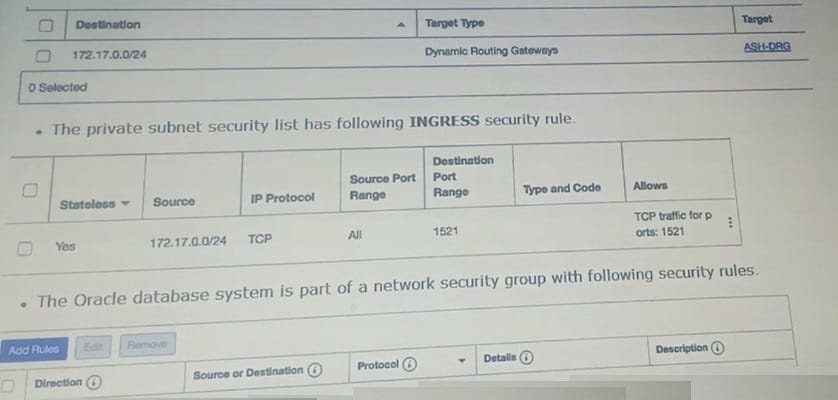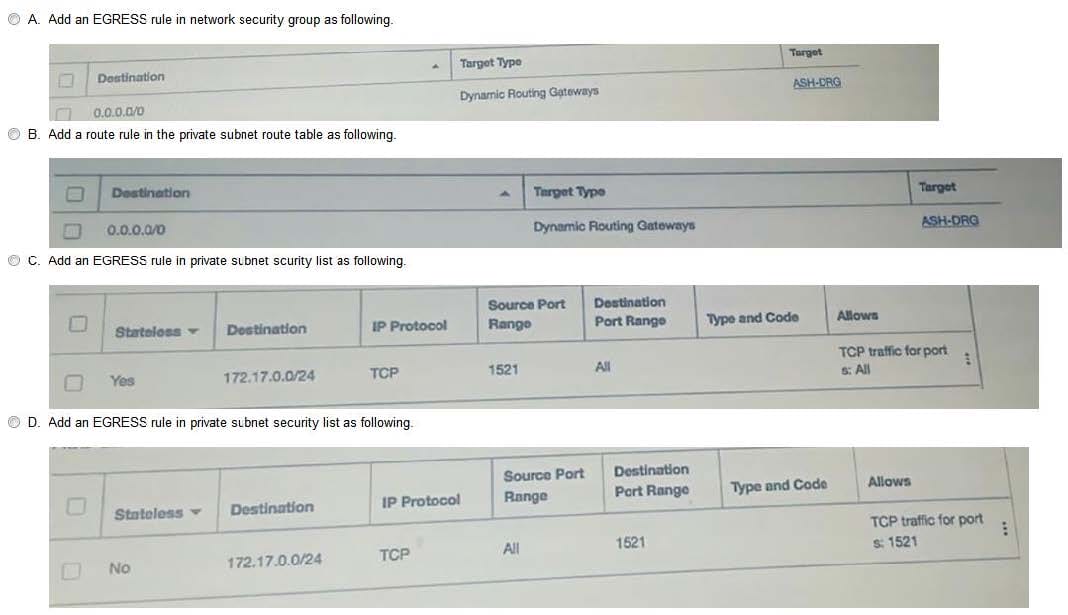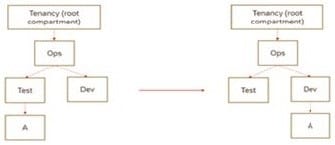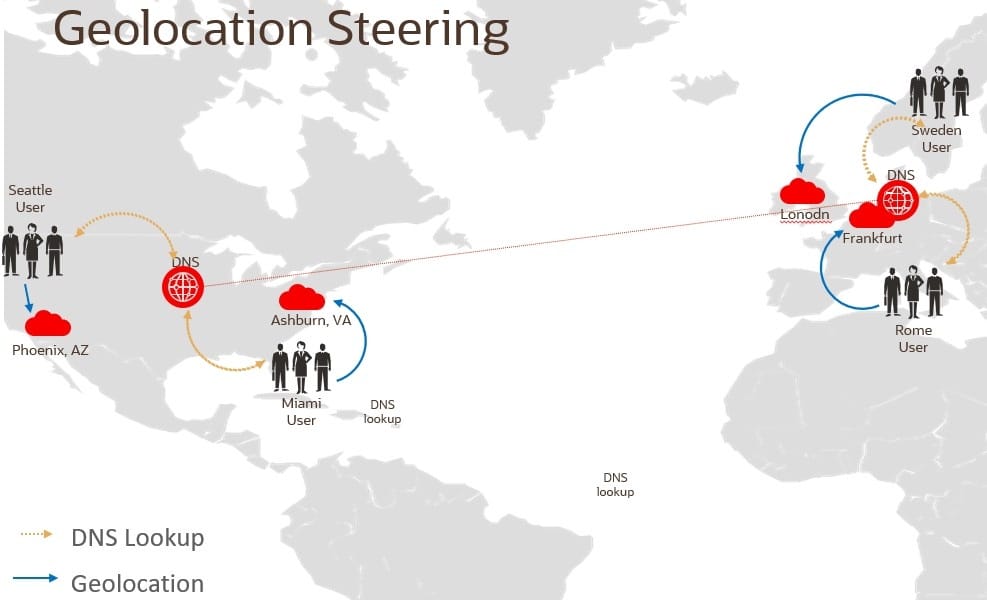1Z0-997-22 Online Practice Questions and Answers
A cloud engineer needs to enable routing between two Virtual Cloud Networks (VCN) from his tenancy. The VCNs are in the same region but in different compartments. After reviewing the IPv4 CIDR prefixes of the two VCNs, he notices that there are no overlapping CIDR blocks.
Which THREE are valid Oracle Cloud Infrastructure (OCI) options for connecting and routing between the two VCNs? (Choose three.)
A. Create two DRGs in the tenancy. Attach one VCN to one of the DRGs; attach the other VCN to the second DRG. In each one of the DRGs, create a Virtual Circuit Attachment. Select FastConnect Partner as the FastConnect type. Select any vendor from the list and complete the circuit at the partner site. Once the FastConnect IPv4 BGP field is in the UP state in each one of the Virtual Circuits, add a route rule in each one of the VCNs' route table to the other VCN using the DRG as the next hop.
B. Create two DRGs in the tenancy. Attach one VCN to one of the DRGs; attach the other VCN to the second DRG. In each one of the DRGs, create a Remote Peering Connection (RPC). Establish a connection from one RPC to the other. In each one of the VCNs' route table, add a route rule to the other VCN using the DRG as the next hop.
C. Create a DRG in the tenancy; add one of the VCN as a VCN attachment. In the other VCN, create a Local Peering Gateway (LPG). Peer the DRG to the LPG. In the VCN attached to the DRG, add a route rule in the route table that points to the DRG as the next hop. In the other VCN, add a route rule in the route table that points to the LPG as the next hop.
D. Add an LPG to each one of the VCNs. In one of the LPG, establish a Peering Connection to the other LPG. In each one of the VCN route table, add a route rule to the other VCN using the LPG as the next hop.
E. Create a DRG in the tenancy; add one of the VCNs as a VCN attachment. In the other VCN, create a Local Peering Gateway (LPG). Peer the DRG to the LPG. In the VCN attached to the DRG, enable BGP routing for the route to propagate to the VCN. In the other VCN add a route rule in the route table that points to the LPG as the next hop.
F. Create a Dynamic Routing Gateway (DRG) in the tenancy, add the two VCNs as VCN attachments and add routes in each one of the VCN route tables with the DRG as the next hop for the CIDR prefix of the other VCN.
A global retailer is setting up the cloud architecture to be deployed in Oracle Cloud infrastructure (OCI) which will have thousands of users from two major geographical regions: North America and Asia Pacific. The requirements of the services are:
*
Service needs to be available 27/7 to avoid any business disruption
*
North American customers should be served by application running In North American regions
*
Asia Pacific customers should be served by applications running In Asia Pacific regions
*
Must be resilient enough to handle the outage of an entire OCI region
A.
OCl DNS, Traffic Management with Failover steering policy
B.
OCl DNS, Traffic Management with Geolocation steering policy. Health Checks
C.
OCl DNS, Traffic Management with Geolocation steering policy
D.
OCl DNS,' Traffic Management with Load Balancer steering policy, Health Checks
You have an Oracle database system in a virtual cloud network (VCN) that needs to be accessible on port 1521 from your on-premises network CIDR 172.17.0.0/24.
You have the following configuration currently.
Virtual cloud network (VCD) is associated with a Dynamic Routing Gateway (DRG), and DRG has an active IPSec connection with your on-premises data center.
Oracle database system is hosted in a private subnet
The private subnet route table has the following configuration
The private subnet route table has following configuration.

However, you are still unable to connect to the Oracle Database system. Which action will resolve this issue?

A. Option A
B. Option B
C. Option C
D. Option D
Your customer has gone through a recent reorganization. As part of this change, they are organizing their Oracle Cloud Infrastructure (OCI) compartment structure to align with the company's new organizational structure. (Refer to the exhibit)

They have made the following change:
Compartment A is moved, and its new parent compartment is compartment Dev.
Policy defined in compartment A: Allow group G1 to manage instance-family in compartment A
Policy defined in root compartment: Allow group admins to manage instance-family in compartment Ops: Test: A
After the compartment move, which action will provide users of group G1 and admins with similar privileges as before the move?
A. Define the following policy in compartment Dev: Allow group G1 to manage instance-family in compartment A
B. Define the following policies in compartment Dev: Allow group G1 to manage instance-family in compartment A Allow group admins to manage instance-family in compartment Ops: Dev: A
C. Define the following policy in compartment: Dev: Allow group admins to manage instance-family in compartment Ops: Dev: A
D. Mo change in any policy statement is required as all the policies associated with a compartment being moved is automatically updated
An online registration system Is currently hosted on one large Oracle Cloud Infrastructure (OCT) Bare metal compute Instance with attached block volume to store of the users' data. The registration system accepts the Information from the user, Including documents and photos then performs automated verification and processing to check it the user is eligible for registration.
The registration system becomes unavailable at tunes when there is a surge of users using the system the existing architecture needs improvement as it takes a long time for the system to complete the processing and the attached block volumes are not large enough to use data being uploaded by the users.
Which Is the most effective option to achieve a highly scalable solution?
A. Attach more Block volumes as the data volume increase, use Oracle Notification Service (ONS) to distribute tasks to a pool of compute instances working In parallel, and Auto Scaling to dynamically size the pool of Instances depending on the number of notifications received from the Notification Service. Use Resource Manager stacks to replicate your architecture to another region.
B. Change your architecture to use an OCI Object Storage standard tier bucket, replace the single bare metal instance with a Oracle Streaming Service (OSS) to ingest the Incoming requests and distribute the tasks to a group of compute Instances with Auto Scaling
C. Upgrade your architecture to use a pool of Bare metal servers and configure them to use their local SSDs for faster data access Set up Oracle Streaming Service (OSS) to distribute the tasks to the pool of Bare metal Instances with Auto Scaling to dynamically increase or decrease the pool of compute instances depending on the length of the Streaming queue.
D. Upgrade your architecture to use more Block volumes as the data volume Increases. Replace the single bare metal instance with a group of compute instances with Auto Scaling to dynamically increase or decrease the compute instance pools depending on the traffic.
A cloud consultant is working on a implementation project on Oracle Cloud Infrastructure (OCI). As part of the compliance requirements, the objects placed in OCI Object Storage should be automatically archived first and then deleted. He is testing a lifecycle policy on Object Storage and created a policy as below:

What will happen after this policy is applied?
A. All the objects having file extension "doc" will be archived for 5 days and will be deleted 10 days after object creation.
B. All objects with names starting with "doc" will be deleted after 5 days of object creation.
C. All the objects having file extension "doc" will be archived 5 days after object creation.
D. All the objects with names starting with "doc" will be archived 5 days after object creation and will be deleted 5 days after archival.
You are working on the migration of the web application infrastructure of your company from on-premises to Oracle Cloud Infrastructure. You need to ensure that the DNS cache entries of external clients will not direct them to the on-premises infrastructure after switching to the new infrastructure.
Which of the following options will minimize this problem?
A. Reduce the TTL of the DNS records after the switch.
B. DNS changes propagate fast enough that it is not necessary to take any action.
C. Increase the TTL of the DNS records before the switch.
D. Increase the TTL of the DNS records after the switch.
E. Reduce the TTL of the DNS records before the switch.
An eCommerce company is running on Oracle Cloud Infrastructure (OCI) and many compute instances remain unused for the most part of the year except during Black Friday and Christmas. You suggest them to use OCI's
Autoscaling feature and present them a slide to showcase the features of Autoscaling.
Which option below is inaccurate in your presentation to the customer?
A. A cooldown period between Autoscaling events lets the system stabilize at the updated level.
B. When an instance pool scales in, instances are terminated in this order: the number of instances is balanced across Availability Domains, and then balanced across Fault Domains. Finally, within a Fault Domain, the newest instance is terminated first.
C. Autoscaling relies on performance metrics such as CPU utilization that are collected by OCI Monitoring service to trigger an Autoscaling event.
D. Autoscaling requires an instance pool as a pre-requisite so that it can automatically adjust the number of compute instances in an instance pool.
You are trying to delete a compartment. The delete operation is falling and you need to troubleshoot the problem.
Which step should NOT be considered when troubleshooting this issue?
A. Verify that there are no policies In the root compartment that reference the compartment you are trying to delete.
B. Verify that you have removed all resources from the compartment.
C. Make sure you have at least one more compartment in your tenancy other than the root compartment.
D. Search for resources in the compartment for each region that your tenancy is subscribed to.
You are working as a security consultant with a global insurance organization which is using Microsoft Azure Active Directory as an identity provider to manage user login/passwords. When a user logs in to Oracle Cloud Infrastructure (OCI) console, it should get authenticated by Azure AD.
Which set of steps are required to be configured in OCI to meet this requirement?
A. Setup Azure AD as an Identity Provider, import users and groups from Azure AD to OCI, set up IAM policies to govern access to Azure AD groups.
B. Setup Azure AD as an Enterprise Application, configure OCI for single sign-on, map Azure AD groups to OCI groups, set up the IAM policies to govern access to Azure AD groups.
C. Setup Azure AD as an Enterprise Application, map Azure AD users, groups and policies to OCI groups and users.
D. Setup Azure AD as an Identity Provider, map Azure AD groups to OCI groups, set up the IAM policies to govern access to Azure AD groups.
You work for a retail company and they developed a Microservices based shopping application that needs to access Oracle Autonomous Database from the application. As an Architect, you have been tasked to treat all of the application
components as Kubernetes native objects, such as the microservices, Oracle
Autonomous database, Kubernetes services, etc.
What should you do to make sure that you can use Kubernetes constructs to manage the life cycle of the application components, including Oracle Autonomous Database? (Choose the best answer.)
A. Create an Oracle Cloud Infrastructure (OCI) Service Gateway and connect to the Oracle Autonomous Database using the private IP address from the microservice.
B. Provision an Oracle Autonomous Database and then use OCI Service Broker to access the database as a native component to your Kubernetes cluster.
C. Create a service from the Kubernetes cluster and point to the Oracle Autonomous Database using its FQDN.
D. Install and secure the OCI Service Broker for Kubernetes. Then provision and bind to the required Oracle Cloud Infrastructure services.
You are using the Oracle Cloud Infrastructure (OCI) OS Management service to manage updates and patches for the Oracle Linux 8 environments on your compute instances in OCI. You have verified that the OS Management Service Agent (osms-agent) is installed and running properly in the instances.
One of the compute instances is not getting the updates from OS Management Service. You use the following command to validatethatyourinstance cannot reach the OS Management Ingestion service by running curl https://ingestion.osms.
Which Is NOT a possible reason for this issue?
A. The instance Is in a private subnet with a NAT gateway.
B. The instance is in a private subnet with a privateendpointwith security rules configured to access the OS Managementingestion service
C. The instance is in a private subnet with a service gatewaythat uses the All
D. The Instance is in a publicsubnet with an Internet gateway.
You are responsible for migrating your on premises legacy databases on 11.2.0.4 version to Autonomous Transaction Processing Dedicated (ATP-D) In Oracle Cloud Infrastructure (OCI). As a solution architect, you need to plan your migration approach.
Which two options do you need to implement together to migrate your on premises databases to OCI?
A. Use Oracle Data Guard to keep on premises database always active during migration
B. Retain changes to Oracle shipped privileges, stored procedures or views In the on- premises databases.
C. Use Oracle GoldenGate replication to keep on premises database online during migration.
D. Convert on-premises databases to PDB, upgrade to 19c, and encrypt Migration.
E. Retain all legacy structures and unsupported features (e.g. taw U>Bs) In the onuses databases for migration.
You have deployed a multi-tier application with multiple compute instances in Oracle Cloud Infrastructure. You want to back up these volumes and have decided to use Volume Group's feature. The Block volume and Compute instances exist in different compartments within your tenancy.
Periodically. a few child compartments are moved under different parent compartments, and you notice that sometimes volume group backup fails.
What could be the cause?
A. You are exceeding your volume group backup quota configured.
B. You have the same block volume attached to multiple compute instances; if these compute instances are in different compartments then all concerned compartments must be moved at the same time.
C. Compute instance with multiple block volumes attached cannot move when a compartment is moved.
D. The Identity and Access Management policy allowing backup failed to move when the compartment was moved.
You are running a mission-critical database application in Oracle Cloud Infrastructure (OCI). You take regular backups of your DB system to OCI Object Storage. Recently, you notice a failed database backup status in the console.
What troubleshooting action can you perform to determine the cause of the backup failure?
A. Ensure that the database is not active and running while the backup is in progress.
B. Ensure that your database host can connect to OCI Object Storage.
C. Ensure that the dcsagent program is not restarted in case of a stop/waiting status.
D. Ensure the database archiving mode is set to NOARCHIVELOG.

